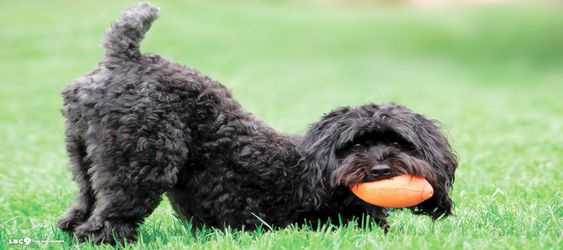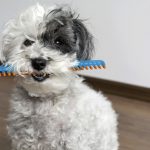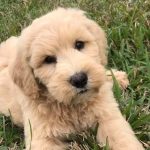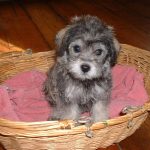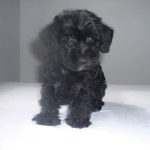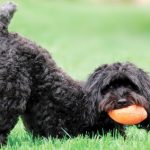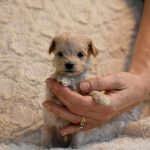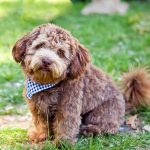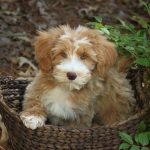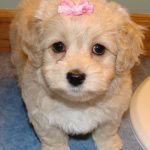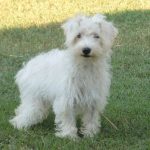What is a Schnoodle?
The “Schnoodle Doodle” (a common term for the Poodle mix) is a Schnauzer Poodle mix. They are developed by crossing the smaller breeds of the Poodle and Schnauzer and make the perfect lap, companion and therapy dogs.
Origin/History of Schnoodle Dogs
The origin of these dogs in actuality as documented began in 1980 in the United States of America by crossing the Poodle and Schnauzer, with the first purposeful crossbreeding done in Minnesota.
The goal was to achieve the perfect dog for people who want companion breeds and who suffer from allergies to dog dander, as well as those who prefer not to have dog hair coating their clothing and home.
Though it has not gained sufficient popularity in comparison to the other designer breeds, Schnoodle puppies are being highly sought after at present.
Editor’s Recommendation: Sheepadoodle Dog Breeds
At present breeders have also begun creating multigenerational Schnoodle where one dog of this breed is bred with the other.
Pictures of Schnoodles (Schnauzer-Poodle Mix)
Appearance of Schnoodle
These dogs may have a strong built and rough hair similar to their Schnauzer parent or curly hair and slender body of the Poodle.
Their round, fluffy head, almond-shaped eyes, short muzzle, black nose and floppy, hanging ears give them a teddy bear-like look.
Poodles come in a wide variety of different colors These dogs are often solid-colored, though they can be bicolor or tricolor as well.
- Grey
- Black
- Brown
- White, Beige, Cream, Silver
- Sable, Apricot, Red
- Black and White
- Black and Tan
Quick Information about Schnoodle Dog Breed
| Characteristics | Details |
|---|---|
| Name | Schnoodle |
| Other Names | Schnauzerdoodle, Schnauzerpoo |
| Color | Brown, Black, White, Gray, Black and Tan, White, Silver, Red, Apricot or even Part-colored |
| Coat | Fine, Soft, Smooth, Dense, and Curly, or Wiry and Wavy |
| Breed Type | Crossbreed |
| Breed Group | Companion Dog Designer Dogs |
| Size | Small Sized Dog |
| Hieght | Toy Schnoodle: 10 to 12 inches (25.4 to 30.48 cm) Miniature Schnoodle: 12 to 15 inches Standard Schnoodle: 15 to 26 inches |
| Weight | Toy Schnoodle: 6 to 10 pounds Miniature Schnoodle: 13 to 20 pounds Standard Schnoodle: 20 to 75 pounds |
| Life Span/Life Expentancy | 10 to 16 years |
| Temperament | Loving, Playful, Affectionate, Intelligent, Strong-Willed, Active, Clever, Protective, Alert, |
| Shedding | Minimum |
| Hypoallergenic | Yes |
| Barking Level | Might inherit the high-pitched bark of its Schnauzer parent and bark frequently especially when bored, insecure or not trained well. |
| Energy Level | Active |
| Good with Children | Yes |
| Good with Other Dogs | Yes |
| Litter Size | 4-7 puppies |
| Country of Origin | U.S.A |
| Competitive Registration/Qualification Information | DDKC, DBR, ACHC, IDCR , DRA, CKC |
Expected Sizes of Adult Schnoodle Dogs
Due to the wide range of sizes in a Schnoodle’s parent breeds, a Schnoodle (full grown) may be small, medium, or large in size. The different Schnoodle varieties are listed below with their expected grown-up sizes.
A Toy Schnoodle (a Toy Poodle crossed with a Miniature Schnauzer) may reach 10-14 inches tall and 4-10 pounds.
A Miniature Schnoodle (a Miniature Schnauzer crossed with a Miniature Poodle) might reach 14 or 15 inches tall and 10-20 pounds.
A Standard Schnoodle (a Standard Poodle crossed with a Standard Schnauzer) could reach 15-19.5 inches tall and 35-60 pounds.
A Giant Schnauzer Poodle (a Standard Poodle crossed with a Giant Schnauzer) 15-27.5 inches tall and 40-85 pounds.
The largest of this variety is the Giant Schnoodle which is developed by crossing the Giant Schnauzer and the Standard Poodle. You might even spot a tiny teacup variety inheriting the genes of the teacup Poodle.
Personality & Temperament of Schnauzerdoodle Dogs
The temperament of the Schnoodle reflects its Schnauzer and Poodle forebears. Regardless of their generation, every Schnoodle will have their own individual traits and characteristics.
The friendly, loving and easy-going disposition of the Schnoodles makes them ideal family dogs. They are alert and playful like the Schnauzer or intelligent, active and obedient as the Poodle.
Poodles also do not like being left out of activities with you or being crated for long periods. They are intelligent, working dogs who want to have something to do or play with, which is why many of them are amazing in the show pen!
Small-sized Schnoodles are well-suited to live in an apartment or urban dwellers, though the larger variations thrive well in large homes having a fenced yard.
Schnoodles form strong ties with their families and dogs are never very happy when they find themselves left on their own for longer periods of time. They suffer from separation anxiety and leaving them alone is not recommended as they may get destructive.
Care ~ Exercise, Grooming & Health Problems
Exercise
Schnoodles, of all sizes, is quite energetic and lively dogs and as such, they need the right amount of exercise every day combined with as much mental stimulation as possible to prevent them from getting bored. These dogs require socialization with other dogs, children, and adults to prevent possible territorial behavior.
They need anything from 40 to 60-minutes exercise or a walk a day with as much off the lead time as possible. If they are not given the right amount of mental stimulation and exercise every day, a Schnoodle would quickly get bored and could even begin to show some destructive behaviors, which is their way of relieving any stress they are feeling and not necessarily because they are being naughty.
Grooming
Grooming requirements depend on the type of coat that the Schnoodle inherits with the wiry Schnauzer-type coat generally requiring less maintenance than that of the Poodle parent.
As a general rule, most need at least twice-weekly brushing with occasional baths, perhaps on a monthly basis. The Schnoodle can look very smart when professionally groomed, and it is best to have this done approximately every two months.
Like any dog, it will sometimes need its nails clipped. This is generally easy to do with the proper equipment, and a Schnoodle that has become accustomed to regular, careful nail clips from puppyhood should be willing to let its owner do this without fuss.
Editor’s Recommendation: Aussiedoodle Dog Breeds
Tooth brushing is another good practice that should begin at a young age and should be done daily for maximum benefit.
Health Problems
The average life expectancy/span of a Schnoodle is between 10 and 15 years when properly cared for and fed timely and appropriate good quality diet to suit their ages and size.
Though a healthy and hardy breed, they might acquire the genetic health issues of both their parents. The conditions that seem to affect the breed the most include the following:
- Hip Dysplasia
- Elbow Dysplasia
- Cataracts
- Epilepsy
- Progressive Retinal Atrophy
Training
Most Schnoodles are exceptionally intelligent dogs and easy to train. These intelligent dogs will be a trainer’s delight when dealt with in a proper way by a firm and skilled instructor.
Socialization and obedience training is to be imparted to the Schnoodle puppies from the beginning to help them develop a pleasing personality.
As they get bored, quite easily try keeping them motivated by positive reinforcement techniques so that they acquire an interest in the training procedure.
If you do not want to go through the tedious task of training your puppy, you may send them to a puppy kindergarten school.
Feedings/Diet
If you get a Schnoodle puppy from a breeder, they would give you a feeding schedule and it’s important to stick to the same routine, feeding the same puppy food to avoid any tummy upsets.
Schnoodles weighing up to 20 pounds can be given three-fourths to one cup of dry dog food of a higher quality daily. Miniature or Toy variants need a lesser amount of food, whereas the quantity for your Giant Schnoodle, should be greater.
Schnoodle Puppies need to be fed a highly nutritious, good quality diet for them to develop and grow as they should. As a rough guide, a Schnoodle puppy can be fed the following amounts every day making sure their meals are evenly spread out throughout the day and it’s best to feed them 3 or 4 times a day.
Dogs should never be exercised just before or just after they have eaten either because this puts them more at risk of suffering from gastric torsion.
Video of Schnoodle Puppies Playing & Adult Schnoodles
Fun-Facts about Schnoodles
- Some Schnoodles love being in the limelight, and they do well in such dog sports as agility, flyball, obedience, and rally, all of which are open to mixed breeds and crossbreeds.
- American actresses Claire Danes and Dakota Fanning have a Schnoodle as their pet.

